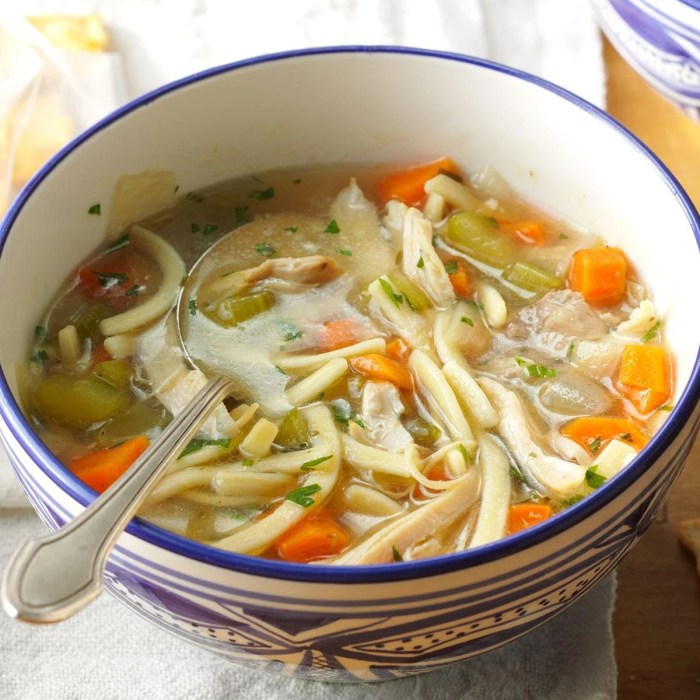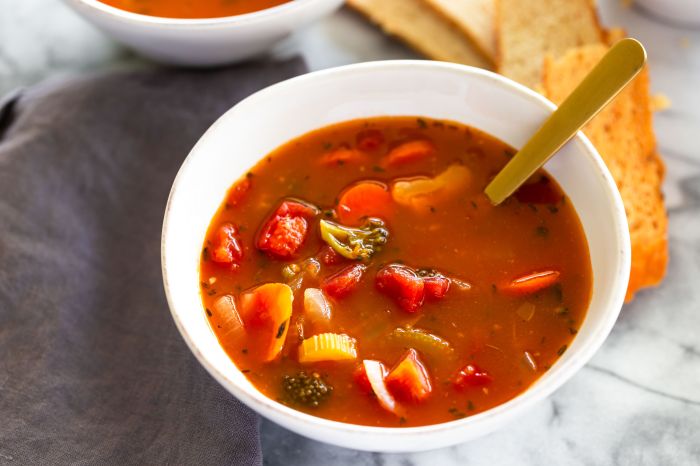The Allure of Homemade Soup: Homemade Recipes For Soup
Homemade recipes for soup – Homemade soup offers a comforting warmth and a taste of home unlike anything store-bought can replicate. From the simmering aromas that fill your kitchen to the satisfaction of creating a nourishing meal from scratch, crafting your own soups is a rewarding culinary journey. This exploration delves into the history, benefits, and diverse possibilities of homemade soup, providing recipes and techniques to elevate your culinary skills.
A Brief History and Benefits of Homemade Soup

Source: tmbi.com
The art of making soup dates back centuries, with evidence suggesting its existence in ancient civilizations. Early soups likely served as a way to preserve food and utilize readily available ingredients. Today, homemade soups offer numerous benefits, including control over ingredients (allowing for healthier options and the avoidance of preservatives), cost-effectiveness, and the ability to cater to individual dietary needs and preferences.
The versatility of homemade soups allows for endless creative exploration, making it a truly fulfilling culinary experience.
The Versatility of Homemade Soups
Homemade soups transcend mere sustenance; they are canvases for culinary creativity. From hearty and filling options perfect for chilly evenings to light and refreshing choices ideal for warmer days, the possibilities are endless. The adaptability of soup recipes allows for incorporating seasonal ingredients, leftover vegetables, and even dietary restrictions, making it a truly versatile and sustainable meal option.
Popular Soup Types and Their Variations, Homemade recipes for soup
Several soup types have earned enduring popularity due to their comforting flavors and adaptable nature. Below are five popular soup types with three variations each, showcasing the vast range of possibilities within each category.
| Soup Type | Variation 1 | Variation 2 | Variation 3 |
|---|---|---|---|
| Vegetable Soup | Classic Vegetable Soup (carrots, celery, potatoes, onions) | Mediterranean Vegetable Soup (zucchini, tomatoes, eggplant, olives) | Roasted Vegetable Soup (butternut squash, sweet potatoes, Brussels sprouts) |
| Chicken Noodle Soup | Classic Chicken Noodle Soup (chicken broth, noodles, carrots, celery) | Creamy Chicken Noodle Soup (added cream or milk) | Spicy Chicken Noodle Soup (added chili flakes or a dash of hot sauce) |
| Tomato Soup | Classic Tomato Soup (fresh tomatoes, basil, garlic) | Roasted Tomato Soup (roasted tomatoes for a deeper flavor) | Creamy Tomato Soup (blended with cream for a richer texture) |
| Lentil Soup | Classic Lentil Soup (brown or green lentils, carrots, celery) | Spicy Lentil Soup (added curry powder or cumin) | Lentil Soup with Sausage (Italian sausage added for extra flavor) |
| Minestrone Soup | Classic Minestrone (vegetables, beans, pasta) | Vegetarian Minestrone (no meat added) | Minestrone with Pesto (added pesto for a fresh, herby flavor) |
Essential Ingredients and Techniques
Mastering a few key ingredients and techniques unlocks the world of delicious homemade soups. Understanding how to properly sauté, simmer, and puree ingredients is crucial for achieving the desired texture and flavor profile.
- Common Ingredients: Onions, garlic, carrots, celery, potatoes, tomatoes, broth (vegetable, chicken, beef), herbs (bay leaf, thyme, rosemary), spices (salt, pepper, cumin, paprika).
- Sautéing: This technique involves cooking ingredients in a small amount of fat over medium heat, enhancing their flavor and creating a flavorful base for the soup.
- Simmering: This gentle cooking method, at a low temperature just below boiling, allows flavors to meld and ingredients to soften without burning.
- Pureeing: Using an immersion blender or regular blender, this technique creates a smooth and creamy texture, especially useful for vegetable and tomato soups.
- Storage: Store leftover soup in airtight containers in the refrigerator for up to 3-4 days. For longer storage, freeze in airtight containers, ensuring to leave some headspace to allow for expansion.
Hearty Vegetable Soup Recipe
This recipe provides a foundation for a delicious and adaptable vegetable soup. Feel free to substitute vegetables based on your preferences and seasonal availability.
Ingredients: 1 tbsp olive oil, 1 onion (chopped), 2 carrots (chopped), 2 celery stalks (chopped), 2 potatoes (diced), 4 cups vegetable broth, 1 can (14.5 oz) diced tomatoes, 1 cup green beans (trimmed), 1 cup corn kernels, salt and pepper to taste.
Instructions: Sauté onion, carrots, and celery in olive oil until softened. Add potatoes and broth, bring to a boil, then reduce heat and simmer for 15 minutes.Stir in tomatoes, green beans, and corn. Simmer for another 10 minutes, or until vegetables are tender. Season with salt and pepper to taste.
Customize this recipe by adding other vegetables like zucchini, bell peppers, or mushrooms. For a heartier soup, add lentils or beans. For a creamier texture, blend a portion of the soup before serving.
Classic Chicken Noodle Soup Recipe
This recipe provides a comforting and classic chicken noodle soup. A quicker version is also provided for busy weeknights.
Ingredients: 1 tbsp olive oil, 1 onion (chopped), 2 carrots (chopped), 2 celery stalks (chopped), 8 cups chicken broth, 1 cup cooked chicken (shredded), 1 cup egg noodles, salt and pepper to taste.
Instructions: Sauté onion, carrots, and celery in olive oil until softened. Add chicken broth, bring to a boil, then add noodles and chicken.Reduce heat and simmer for 10-12 minutes, or until noodles are cooked through. Season with salt and pepper to taste.
Quick Version: Use pre-cooked rotisserie chicken and pre-cut vegetables to reduce prep time. Use quick-cooking noodles to shorten the cooking time.
- Potential Substitutions: Chicken broth can be substituted with vegetable broth for a vegetarian version. Different types of noodles can be used, such as rice noodles or pasta.
Creamy Tomato Soup Recipe

Source: myfoodstory.com
This recipe details the creation of a creamy tomato soup, highlighting the impact of using fresh versus canned tomatoes.
Ingredients: 2 tbsp olive oil, 1 onion (chopped), 2 cloves garlic (minced), 28 oz canned crushed tomatoes, 4 cups vegetable broth, 1 cup heavy cream, salt and pepper to taste.
Instructions: Sauté onion and garlic in olive oil until softened. Add crushed tomatoes and broth. Bring to a boil, then reduce heat and simmer for 20 minutes.Blend soup until smooth. Stir in heavy cream and season with salt and pepper to taste.
For a smoother texture, strain the soup after blending. Fresh tomatoes can be roasted for a deeper, richer flavor. Using fresh tomatoes may require adjusting the liquid amount to achieve the desired consistency.
Recipe Adaptations for Dietary Restrictions
Many soup recipes can be easily adapted to accommodate various dietary restrictions.
- Gluten-Free: Use gluten-free noodles or pasta, or omit pasta altogether.
- Vegan/Vegetarian: Use vegetable broth and omit any meat or dairy products. Consider adding nutritional yeast for a cheesy flavor.
- Low-Sodium/Low-Fat: Use low-sodium broth and reduce or omit added salt. Use less oil and substitute heavy cream with light cream or milk.
Serving Suggestions and Garnishes

Source: thespruceeats.com
Homemade soup recipes offer endless possibilities for culinary creativity. One particularly comforting option is a creamy potato soup, and for a truly decadent version, you might want to check out this fantastic recipe: potato soup recipe with cream cheese. Whether you prefer a simple broth or a richer, creamier texture, homemade soups provide a satisfying and customizable meal.
Elevating the presentation of your homemade soup can significantly enhance the dining experience.
- Serving Suggestions: Serve with crusty bread, grilled cheese sandwiches, or a side salad.
- Garnishes: Fresh herbs (parsley, chives, basil), croutons, a dollop of sour cream or yogurt, shredded cheese, a drizzle of olive oil.
- Presentation: Serve in bowls that complement the soup’s color and style. Garnish thoughtfully to create a visually appealing presentation.
Troubleshooting Common Soup-Making Problems
Addressing common soup-making challenges ensures a consistently delicious outcome.
| Problem | Solution |
|---|---|
| Soup is too salty | Add a peeled potato or a few slices of raw potato to the soup to absorb excess salt. Alternatively, add more broth or water to dilute the saltiness. |
| Soup is too thin | Simmer the soup uncovered for a longer period to reduce the liquid. Alternatively, thicken the soup by adding a cornstarch slurry (mix cornstarch with cold water before adding to the soup). |
| Soup is too thick | Add more broth or water to thin the soup to your desired consistency. |
Storing and Freezing Homemade Soup
Proper storage techniques ensure the longevity and quality of your homemade soups.
- Refrigerator Storage: Store leftover soup in airtight containers in the refrigerator for up to 3-4 days.
- Freezing: Allow soup to cool completely before freezing in airtight containers. Leave some headspace to allow for expansion during freezing.
- Preventing Freezer Burn: Ensure the containers are tightly sealed and leave minimal air space. Consider using freezer-safe bags for smaller portions.
Helpful Answers
Can I freeze leftover soup?
Yes, absolutely! Allow the soup to cool completely before freezing in airtight containers. It will generally keep for 3-4 months.
How can I thicken my soup?
You can thicken soup by adding a cornstarch slurry (mix cornstarch with cold water), a roux (butter and flour cooked together), or pureeing a portion of the soup.
What should I do if my soup is too salty?
Add a peeled and diced potato or a cup of uncooked rice to the soup. These will absorb some of the excess salt. You can also add a splash of lemon juice or cream to balance the saltiness.
How long does homemade soup last in the refrigerator?
Homemade soup typically lasts for 3-5 days in the refrigerator when stored properly in an airtight container.
